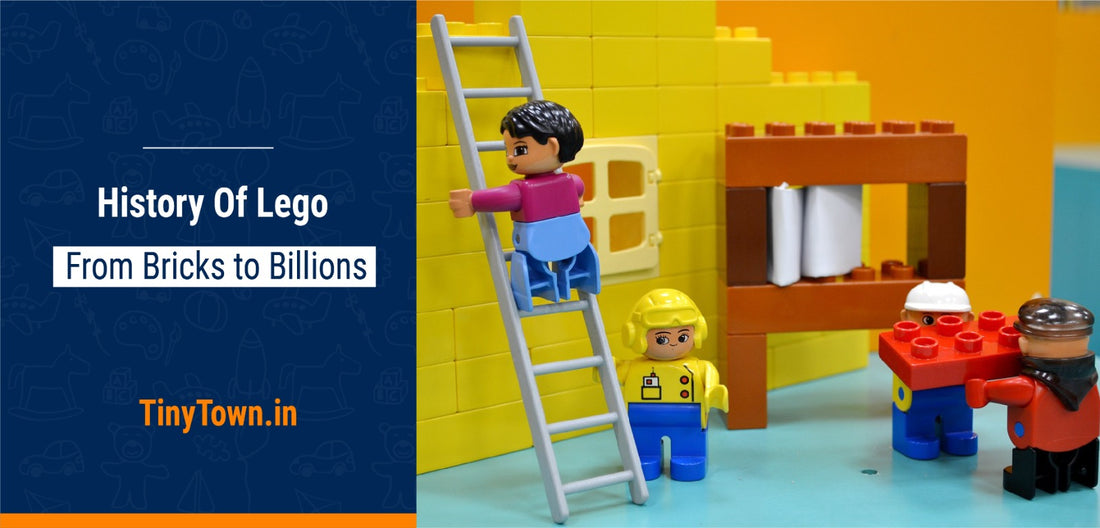The history of Lego dates back to the early 1930s when Danish carpenter Ole Kirk Christiansen founded the company. Initially named "The Lego Group" in 1934, it wasn't until the late 1940s that the iconic Lego bricks emerged.
Christiansen introduced interlocking plastic bricks in 1949. Since then, Lego has become a household name, captivating generations of children. Its success lies in its simple, yet original design and also in the company's commitment to continuous innovation, adaptability and catching on to current trends among children.
Over the years, Lego expanded its product line, introducing themed sets, licensed partnerships, and even theme parks, evolving into a global phenomenon that has impacted almost everyone in every sphere.
The Origins of LEGO
The origins of LEGO can be traced back to the small town of Billund, Denmark, where Ole Kirk Christiansen laid the foundation for a toy empire in 1932. Initially, the company was called "The LEGO Group" (derived from the Danish words "Leg Godt", meaning "play well"), and it produced wooden toys, including pull-along ducks and cars.
However, it wasn't until 1949 that LEGO introduced the iconic interlocking brick system that would revolutionize the toy industry. These bricks, known today as LEGO bricks, allowed children to build and create endless structures.
Since 1963, Lego pieces have been made from a strong, resilient plastic known as acrylonitrile butadiene. Currently, LEGO’s factories are set up in Germany, Mexico, Hungary, and China.

The introduction of LEGO sets and themes in the following years further ensured the company's success, captivating generations of children with their universal appeal and commitment to quality.
The LEGO System: A Legacy of Innovation
What sets Lego apart from the competition is its commitment to innovation, continually evolving its product range to meet the ever-changing needs of its customers. Whether through the introduction of new themes, the incorporation of cutting-edge technologies, or the creation of immersive experiences, here are a few things that set LEGO apart in the market from its competitors.
1. Introducing The LEGO System And Its Unique Design
With its iconic interlocking bricks, this timeless toy has captured the imagination of millions around the world since its inception in 1949.
What sets the LEGO System apart is its unique and ingenious design. Each brick is carefully crafted with precision, ensuring a snug fit that allows builders to connect and disconnect pieces effortlessly.
Lego pieces of all varieties have a universal mechanism. Despite differences in the design and the purposes of individual pieces over the years, each piece remains compatible in some way with existing pieces.

This innovative design enables limitless possibilities, as builders can create structures, vehicles, and even entire worlds using these versatile bricks. The bricks are made from durable plastic, ensuring that the creations withstand the rough play hours of children.
2. The development Of The Interlocking Brick System
This innovative design concept was introduced by Ole Kirk Christiansen, the founder of LEGO, in 1958. The interlocking brick system consisted of small plastic bricks that were cleverly designed to fit together snugly.
Lego bricks from 1958 still interlock with those made in the current time, and Lego sets for young children are compatible with those made for teenagers. Six bricks of 2 × 4 studs can be combined in 915,103,765 ways.
As of now, the design teams use 3D modelling software to generate CAD drawings from initial design sketches. The designs are then prototyped using an in-house stereolithography machine. These prototypes are presented to the entire project team for comment and testing by parents and children during the "validation" process.
Each Lego piece must be manufactured with a high degree of precision. When two pieces are engaged, they must fit firmly, yet be easily disassembled. The machines that manufacture Lego bricks have tolerances as small as 10 micrometers.
3. The Introduction Of LEGO Sets And The Rise Of Themed LEGO Collections
As the years went by, the popularity of LEGO grew exponentially, leading to an evolution in the form of themed LEGO collections. With the rise of themed collections, children were no longer limited to basic building blocks but were introduced to intricate worlds and narratives that could be reconstructed in their own homes.

From the iconic LEGO Star Wars series, allowing kids to recreate their favourite space battles, to themed LEGO cities and even beloved film adaptations like Batman, Indiana Jones, Pirates of the Caribbean, Harry Potter, Marvel and Minecraft the video game.
This new wave of LEGO sets brought excitement and creativity to a whole new level, captivating young minds and igniting their passion for storytelling and innovative construction.
Impact on Play and Education
The colourful, interlocking bricks have captured the imagination of children for generations, fostering creativity and critical thinking skills.
As they construct their imaginative worlds and structures, Lego encourages problem-solving abilities, spatial awareness, and fine motor skills development. Moreover, Lego has also made significant strides in educational settings, with educators incorporating Lego-based activities to promote hands-on learning in subjects like math, science, and even coding.

By seamlessly integrating play and education, Lego has successfully revolutionized the way young minds engage with knowledge, igniting a passion for exploration and discovery that transcends traditional teaching methods.
Cultural Impact Of LEGO On Movies, Books, And Video Games
The cultural impact of LEGO on movies, books, and video games is too many to pick from. From its humble beginnings as a toy, LEGO has transcended its primary function to become a powerful medium that influences and shapes popular culture.
LEGO-themed movies, such as "The LEGO Movie" and its sequels, have captivated audiences of all ages, spreading the spirit of creativity, imagination, and teamwork. Furthermore, LEGO-inspired books, ranging from novels to comics, have expanded the LEGO universe and enriched storytelling for generations.
In the world of video games, LEGO franchises have become a staple, allowing players to immerse themselves in brick-built worlds and embark on exciting adventures.
As we already said, LEGO has also infiltrated books and clothing. The first was The Ultimate Lego Book, which was published in 1999. Then in 2009, the same publisher produced The LEGO Book, which was sold in a slipcase along with Standing Small: A Celebration of 30 Years of the LEGO Minifigure, a smaller book focused on the minifigure.
In 2012, a revised edition was published. Also in 2009, DK published books on Lego Star Wars and a range of Lego-based sticker books. Kabuki, a Danish company along with Nike and Adidas collaborated with the Toy Company to make apparel for all.
The Global Community
With millions of users spanning different countries and cultures, Lego has successfully built a diverse network of enthusiasts who are united by their love for these coloured bricks.
This global community serves as a vibrant platform for people to share their meticulously constructed masterpieces, exchange building techniques, and ignite inspiration in others.
Since its inception in 1996, the Lego website has developed over the years and provides many extra services beyond an online store and a product catalogue.
The Lego website features a social media app named Lego Life which is designed for children under 13 years of age. The app is available as a free download and only features Lego-related content.
It was designed to be a social network for children to be inspired, create and share their Lego builds, photos and videos with a like-minded community, whilst also providing Lego content in the form of product advertising, images, videos, campaigns and competitions.
The app incorporates a variety of child safety features to provide a safe digital environment for children, including the protection of personal information and the heavy moderation of all uploaded user-generated content and communication.
LEGO's Journey Through Challenges
Lego has overcome numerous obstacles along the way. One of the company's main challenges was adapting to the digital age, as children became increasingly captivated by screens and virtual experiences.
However, Lego successfully transformed its brick-and-mortar business into a digital empire by embracing new technologies like augmented reality and creating interactive games and apps.
Another significant hurdle was sustainability, with rising concerns about plastic waste. Despite this, Lego took a proactive stance and committed to producing their famous bricks from plant-based materials by 2030.
By constantly innovating and addressing these obstacles head-on, Lego has managed to maintain its popularity and retain its position as a leader in the toy industry.
Conclusion
LEGO has empowered generations of children to explore their imagination, develop problem-solving skills, and foster their artistic talents.
Moreover, LEGO's ability to adapt to changing times and embrace new technologies has helped it withstand various challenges and remain at the forefront of the industry.
With a rich history spanning over eight decades, LEGO continues to captivate young and old alike, reminding us that playfulness, learning, and boundless possibilities are timeless treasures.
So, if you would like to buy a LEGO set, then TinyTown is the best online destination for you to visit. We have thousands of LEGO sets, all created with incredible detail and care. So, do you want to add more exquisite cars to your collection? Shop with us and check out our exclusive collection.

